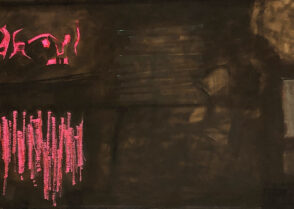James "Jack" Boynton
(American, 1928-2010)
Causeway, 1955
Casein; 12 x 40 inches
Gift of Linda and William Reaves, The Linda and William Reaves Collection of Texas Art at UHV, 2022
In 1954, James “Jack” Boynton participated in the landmark exhibition Younger American Painters at the Whitney Museum of Modern Art. The following year, the year of Causeway’s creation, Boynton earned a faculty position at the University of Houston. During his time at the University of Houston, Boynton joined the city’s burgeoning avant-garde. Like his peers Jim Love, Dick Wray, Dorothy Hood, and Richard Stout, Boynton worked to revitalize and reconstruct the Houston art scene. These artists made considerable strides in bringing fresh, globally conscious styles and ideas to Houston. Inspired and shaped by Abstract Expressionism, Art Brute, Tachism, and Art Informel, Houston’s avant-garde quickly garnered national attention. Following his tenure at the University of Houston, Boynton would go on to exhibit at the Museum of Modern Art and the Museum of Fine Arts, Houston.
Like the majority of Boynton’s oeuvre, Causeway employs abstraction in its quest to create meaning. This work realistically represents a manmade causeway, ubiquitous to the Texas Gulf coast. The abstract blue, purple, and brown blocks unite to form a bridge-like structure. The blueish greys serve as water. The oranges and yellows read as sunlight. However, Causeway’s meaning changes when read as an abstraction. The elements of reality that charge the artwork with representational meaning fracture and rearrange. They coalesce into an abstract mosaic of reality. The work’s shapes and symbols no longer beg for recognition or remembrance. Instead, they draw attention to the artwork’s form, color, and materiality. They evoke feelings and emotions, not images.
Born in 1928 in Fort Worth, James “Jack” Boynton was a key figure in the post-World War II Houston avant-garde. After graduating from Lamar High School in Houston, Boynton earned a bachelor’s and master’s degree from Texas Christian University. He began exhibiting his works in the early 1950s. By the end of the decade, he had won the Purchase Prize, earned a solo exhibition at the Fort Worth Art Center, and garnered national attention.
Location
University of Houston-Victoria
STEM Building


